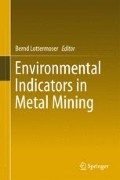Abstract
Best practice for acid rock drainage (ARD) risk assessment predominately relies on the geochemical properties of sulfidic rocks. Consequently, a plethora of geochemical tests are routinely utilised by the mining industry to predict ARD formation. Due to limitations associated with these tests and their relatively high costs, analysis of recommended best practice sample numbers is rarely achieved, thus reducing the accuracy of waste management plans. This research aimed to address this through identifying potential geometallurgy indicators using drill core samples (n = 70) obtained from the Comstock Chert, a new prospect proximal to Mount Lyell, western Tasmania, Australia. Samples were subjected to a range of mineralogical analyses, routine ARD geochemical tests (i.e., paste pH; acid-base accounting , ABA; net acid generation, NAG), field-based techniques (e.g., portable X-ray fluorescence, pXRF; short-wave infrared spectrometry, SWIR), and geometallurgical analyses (i.e., HyLogger, Equotip). This study demonstrated: (1) HyLogger data allows identification of acid-neutralizing carbonate minerals; (2) Equotip hardness data provide a conservative indication of lag-time to acid formation; (3) CARD risk grading accurately identifies high and low risk ARD domains; and (4) pXRF data provides a sound indication of the abundance of environmentally significant elements. Consequently, the application of geometallurgical techniques to drill core allows the prediction of ARD characteristics that inform waste characterization and management plans.
Access this chapter
Tax calculation will be finalised at checkout
Purchases are for personal use only
References
Alruiz OM, Morrell S, Suazo CJ, Naranjo A (2009) A novel approach to the geometallurgical modelling of the Collahuasi grinding circuit. Min Eng 22:1060–1067
Corbett KD, Quilty PG, Calver CR (2014) Geological evolution of Tasmania. Geological Society of Australia (Tasmanian Division), Hobart
Hitzman MW (1999) Routine staining of drill core to determine carbonate mineralogy and distinguish carbonate alteration textures. Mineralium Deposita 34: 794–798
Huntington JF, Quigley M, Yang K, Roache T, Young C, Roberts I, Whitbourn LB, Mason P (2006) A geological overview of HyLogging 18,000 m of core from the Eastern Goldfields of Western Australia. In: Proceedings from the 6th international mining geology conference, AusIMM publication series no. 6, Darwin, Australia, pp 45–50
Jambor JL, Dutrizac JE, Raudsepp M (2007) Measured and computed neutralization potentials from static tests of diverse rock types. Environ Geol 52:1019–1031
Keeney L (2008) EQUOtip hardness testing: Aqqaluk (including a guide on how to use EQUOtip). Technical report 2, P843 GeM, Australian Mineral Industries Research Association (AMIRA), Melbourne
Leichliter S, Hunt J, Berry R, Keeney L, Montoya PA, Chamberlain V, Jahoda R, Drews U (2011) Development of a predictive geometallurgical recovery model for the La Colosa, Porphyry Gold Deposit, Colombia. In: Proceedings from the 1st AusIMM international geometallurgy conference. THE Australasian Institute of Mining and Metallurgy, Melbourne, pp 85–92
McLoughlin J, Morrison K (2013) The copper chert discovery, Mount Lyell mineral field Tasmania. In: AUSIMMM mines and wines conference, Orange, NSW, Australia, pp 1–5
Morin KA, Hutt NM (1998) Kinetic test and risk assessment for ARD. In: Proceedings of the 5th annual BC metal leaching and ARD workshop, Vancouver, Canada
Noble TN, Lottermoser BG, Parbhakar-Fox A (2015) Evaluation of pH testing methods for sulfidic mine waste. Mine Water Environ. doi:10.1007/s10230-015-0356-2
Parbhakar-Fox A (2012) Establishing the value of an integrated geochemistry-mineralogy-texture approach for acid rock drainage prediction. PhD thesis, University of Tasmania, Australia
Parbhakar-Fox A, Lottermoser BG (2014) Domaining acid rock drainage risks using geometallurgical data. In: Proceedings from the 8th Australian workshop on acid and metalliferous drainage, ACMER, Brisbane, pp 483–494
Parbhakar-Fox A, Edraki M, Walters S, Bradshaw D (2011) Development of a textural index for the prediction of acid rock drainage. Min Eng 24:1277–1287
Parbhakar-Fox A, Lottermoser BG, Bradshaw D (2013) Evaluating waste rock mineralogy and microtexture during kinetic testing for improved acid rock drainage prediction. Min Eng 52:111–124
Parbhakar-Fox AK, Aalders J, Lottermoser BG (2015) Effective field-based testing tools for rapid ARD prediction. In: 10th international conference on acid rock drainage and IMWA annual conference, Santiago, Chile, pp 890–905
Plumlee GS (1999) The environmental geology of mineral deposits. In: Plumlee GS, Logsdon MJ (eds) The environmental geochemistry of mineral deposits part a: processes, techniques and health issues. Reviews in economic geology, vol 6A, pp 71–116
Price WA (2009) Prediction manual for drainage chemistry from sulphidic geologic materials. CANMET Mining and Mineral Sciences Laboratories, Canada
Smart R, Skinner WM, Levay G, Gerson AR, Thomas JE, Sobieraj H, Schumann R, Weisener CG, Weber PA, Miller SD, Stewart WA (2002) ARD test handbook: project P387A, prediction and kinetic control of acid mine drainage. AMIRA International Ltd, Melbourne
Weber PA, Hughes JB, Conner LB, Lindsay P, Smart RC (2006) Short-term acid rock drainage characteristics determined by paste pH and kinetic NAG testing: cypress prospect, New Zealand. In: Proceedings from the 7th international conference on acid rock drainage, Missouri, pp 2289–2310
Author information
Authors and Affiliations
Corresponding author
Editor information
Editors and Affiliations
Rights and permissions
Copyright information
© 2017 Springer International Publishing Switzerland
About this chapter
Cite this chapter
Parbhakar-Fox, A., Lottermoser, B. (2017). Predictive Waste Classification Using Field-Based and Environmental Geometallurgy Indicators, Mount Lyell, Tasmania. In: Lottermoser, B. (eds) Environmental Indicators in Metal Mining. Springer, Cham. https://doi.org/10.1007/978-3-319-42731-7_9
Download citation
DOI: https://doi.org/10.1007/978-3-319-42731-7_9
Published:
Publisher Name: Springer, Cham
Print ISBN: 978-3-319-42729-4
Online ISBN: 978-3-319-42731-7
eBook Packages: Earth and Environmental ScienceEarth and Environmental Science (R0)

